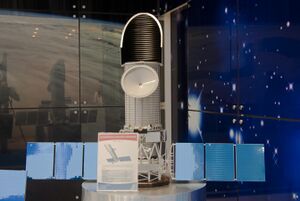Astronomy:Spektr-UV
 Model of WSO-UV telescope during "Space Week" in Madrid, May 2011 | |
| Mission type | Space telescope |
|---|---|
| Operator | Russian Astro Space Center |
| Spacecraft properties | |
| Manufacturer | NPO Lavochkin |
| Payload mass | 2,840 kg (6,261 lb) |
| Start of mission | |
| Launch date | 2030 (proposed)[1] |
| Rocket | Angara A5M[2] |
| Launch site | Vostochny Site 1A |
| Contractor | Roscosmos |
| Main telescope | |
| Wavelengths | 115 to 315 nm |
Spektr program | |
Spektr-UV, also known as World Space Observatory-Ultraviolet (WSO-UV), is a proposed ultraviolet space telescope intended for work in the 115 nm to 315 nm wavelength range.[3][4] It is an international project led by Russia (Roscosmos), with participation from Spain and Japan. The launch had initially been planned for 2007, but has since been continually delayed;[5] as of December 2023, the launch is expected to take place no earlier than 2030[1] atop an Angara A5M rocket from Vostochny Cosmodrome.[2]
Overview
The main instrument of the observatory is a 1.7-metre Ritchey–Chrétien telescope. The telescope will be equipped with the following instruments:
WSO-UV Spectrographs Unit (WUVS) (Russia/Japan)
The WUVS spectrographs assembly consists of four channels:
- Vacuum Ultraviolet Echelle Spectrograph, VUVES (Russia): The FUV high-resolution spectrograph (VUVES) provides echelle spectroscopy capabilities with high resolution (R ~ 50 000) in the 115–176 nm range.
- Ultraviolet Echelle Spectrograph, UVES (Russia): The NUV high-resolution spectrograph (UVES) provides echelle spectroscopy capabilities with R ~ 50 000 in the 174–310 nm range.
- Long-Slit Spectrograph, LSS (Russia): The Long-Slit Spectrograph (LSS) provides low resolution (R ~ 1000), long slit spectroscopy in the 115–305 nm range. The spatial resolution is better than 0.5 arcsec(0.1 arcsec as the best value).
- UV Spectrograph for observation of Earth-like Exoplanets, UVSPEX (Japan)
WSO-UV Field Camera Unit (FCU) (Russia/Spain)
The FCU has two channels, each fed by an independent pick off mirror:
- Field Camera Unit FUV channel (FCU/FUV) (Russia/Spain): The far UV (FUV) channel has capabilities for high resolution imaging through the MCP detector, scale 0,047 arcsec/pixel in 115–190 nm range.
- Field Camera Unit UVO channel (FCU/UVO) (Russia): The UV-optical (UVO) channel is designed for wide field imaging through the CCD detector, scale 0,146 arcsec/pixel in 185–810 nm range.
Proposed and former instruments
- Stellar Coronograph for Exoplanet Direct Imaging, SCEDI (NAOJ, Rikkyo University, Japan).
- HIRDES (High-Resolution Double Echelle Spectrograph): R~55000 spectroscopy of point sources in the 102–320 nm range (Germany). Germany exited the Spektr-UV programme due to financial problems, so Russia replaced HIRDES with WUVES.
- ISSIS (Imaging and Slitless Spectroscopy Instrument for Surveys) was being developed to carry out UV and optical diffraction limited imaging of astronomical objects. The ISSIS would have incorporated three channels: High Sensitivity Far-UV Channel: 120–200 nm; Channel for Surveys (FUV): 120–600 nm, optimized for 120–270 nm; Channel for Surveys (UVO): 120–600 nm, optimized for 270–600 nm (Spain). Due to financial problems, Spain canceled ISSIS, and limited participation in Spektr-UV program to ground segment and supply of detectors for FCU. Russia replaced ISSIS with FCU.
History
In October 2012, tests of antennas for the space telescope were completed.[8]
In July 2019, INASAN selected the first seven experiments to be performed by the observatory.[9]
Participating nations
Spektr-UV is an international project led by Russia (Roscosmos). At present the international cooperation includes three basic participants: Russia (will provide the telescope, spacecraft, launch facilities, ground segment); Spain (FCU detectors, ground segment); Japan (UVSPEX).
See also
References
- ↑ 1.0 1.1 "В Институте астрономии РАН заявили, что обсерваторию "Спектр-УФ" не запустят до 2030 года" (in ru). TASS. 21 December 2023. https://tass.ru/kosmos/19601327.
- ↑ 2.0 2.1 "Ученый рассказал о новом контракте на создание обсерватории "Спектр-УФ"" (in ru). RIA Novosti. 2021-10-15. https://ria.ru/20211015/spektr-uf-1754664585.html.
- ↑ Zak, Anatoly (30 December 2022). "Spektr-UF". RussianSpaceWeb. https://www.russianspaceweb.com/spektr_uf.html.
- ↑ "World Space Observatory - Ultraviolet". 2015. http://wso-uv.es/.
- ↑ "World Space Observatory for the Ultra-Violet (WSO/UV)". http://astro.uni-tuebingen.de/groups/wso_uv/.
- ↑ "WORLD SPACE OBSERVATORY – ULTRAVIOLET USER’S HAND BOOK" https://wso-jcuva.ucm.es/WSO.UsersBook_rev_es.pdf
- ↑ Федеральное государственное бюджетное учреждение науки ИНСТИТУТ АСТРОНОМИИ РОССИЙСКОЙ АКАДЕМИИ НАУК Сборник трудов мемориальной конференции 2018 г., посвященной памяти академика А.А. Боярчука p.346-410 http://www.inasan.ru/wp-content/uploads/2018/12/Boyarchuk.pdf
- ↑ "Завершены испытания антенн космического телескопа "Спектр-УФ"" (in ru). 2012-10-17. https://ria.ru/20121017/903402974.html.
- ↑ "Russian scientists have selected seven experiments for Spektr-UV space telescope project". TASS. 2019-07-06. https://tass.com/science/1067377.
External links
 |


